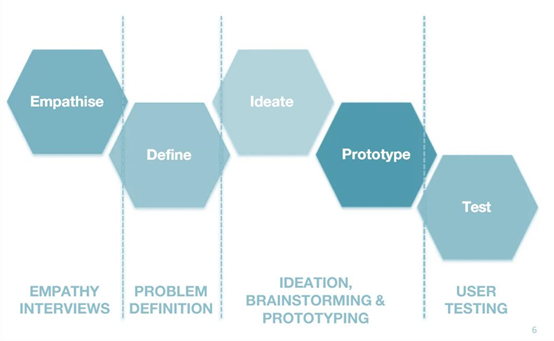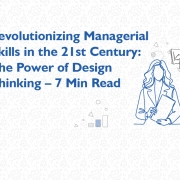Revolutionizing Managerial Skills in the 21st Century: The Power of Design Thinking – 7 Min Read
It is true that problem-solving, decision-making, and creative thinking are highly valued skills in the modern business world, and companies seek managers who possess these skills. However, it is also true that these skills are not always adequately cultivated in management education programs. This leaves many budding managers lacking in these important skills when they enter the workforce. To address this issue, it is essential to take a practical and hands-on approach to management education. Design Thinking approach can help students develop the 21st-century managerial skills that are in high demand in the job market.
One of the benefits of design thinking for management education is that it provides a structured approach to problem-solving that is adaptable to various contexts. It encourages managers to take a user-centered perspective, which involves understanding the needs, desires, and motivations of stakeholders, including customers, employees, and partners. By doing so, managers can create products and services that better meet the needs of their target audience. Another advantage of design thinking is that it fosters creativity and innovation. It encourages managers to challenge assumptions, take risks, and explore new possibilities. By using design thinking, managers can generate novel and effective solutions to complex problems, which can lead to competitive advantages and increased profitability.
Design thinking is practiced not only by designers but also by those who want to know their customers, their problems and those that can be sorted using creativity. This was first practiced by David Kelley, Professor at Stanford University – cofounder of IDEO, in the year 2003.
The Evolution of Management: A Comparison of Past and Present Practices
The traditional approach to management education has focused mainly on concepts and theories, with little emphasis on practical skills and real-world applications. In the modern business world, there are three major things that industry needs from managers, ability to fulfil the expectations, needs, and desires of customers, as this century’s emphasis is all about user experience, ability to leverage technology and innovation to create new products, services, and business models, companies that can harness technology effectively can gain a significant competitive advantage. Finally, managers need to have the skills of compassion, creativity, and collaboration to thrive in the 21st century.
Out performance by Companies using Design Thinking
It has been seen that design-driven companies have outperformed other companies in terms of financial performance, innovation, and customer satisfaction. According to the DMI Design Value Index, which tracks the performance of design-driven companies, these companies have consistently outperformed the S&P 500 index over the past 10 years by a margin of over 200%. This is because design thinking can help companies develop innovative products and services that meet the needs and desires of customers, and create a positive user experience.

Figure 1 Brown, T. (2008) Design Thinking, Harvard Business Review
- Desirability is a critical factor in the success of any product or service. By using design thinking, companies can take a user-centered approach to product development, which involves understanding the desires of their customers.
- Feasibility is a critical factor in the success of any business. It is important to have the right resources, infrastructure, technology, and processes in place to support the business objectives. A company that is not feasible will not be able to sustain itself in the long run.
- Viability is a crucial aspect too of any business, and it includes financial sustainability, profitability, and growth. A business needs to be financially viable to sustain and grow in the long run. This involves managing costs, generating revenue, attracting investment, and creating value for shareholders.
Innovative Management through Design Thinking Strategies
When all management schools are looked globally following are the unmet needs:
- Lack of identifying, analysing and practicing how best to manage when faced with economic, institutional and cultural differences
- Understanding leadership skills, developing alternative approaches of inspiring, influencing and guiding
- Thinking about issues/unstructured situations from variety of perspectives in order to frame problems
- Influencing others and getting things done in context of hidden agendas, rules, political partnerships and POVs.
- Understanding, synthesizing, and filtering large amount of ambiguous data, generating ideas, experimenting ongoing and learning.
- Thinking critically and communicating clearly.
- Lack of understanding the roles, responsibilities and purpose of business as per different stakeholders
- Lack of understanding the limits of models and markets
Navigating the Stages of the Design Thinking Process

Figure 2 Stanford Design Thinking Process
Empathy is a key part of the Design Thinking process, and it involves understanding the needs of the stakeholders that are affected by the problem. Ethnography is one approach to empathizing with stakeholders, where the design team plunges into the stakeholder’s environment. The ethnography study can be done by conducting interviews in order to gain the insights of the stakeholders.
The Define stage in the Design Thinking process involves Design Thinkers synthesize all of the information they have gathered. They must analyze the data, identify patterns and themes, and synthesize this information into a concise and actionable problem statement. This process of defining requires critical thinking i.e., decision-making.
The ideation stage in the Design Thinking process is often seen as the most exciting and enjoyable stage, as it involves generating a wide range of creative and innovative ideas. Design Thinkers use a variety of tools and techniques to stimulate their creativity and generate new ideas. Students develop the ability of innovation using lateral and divergent thinking and tools to generate ideas.
The refinement and through prototyping happens next with user testing. The testing stage lets them iterate the prototype with their stakeholders.
Cultivating a Managerial Mindset
As budding managers, students need to develop a designer mindset, not just managerial. This means approaching problems with a beginner’s mindset, being open to new ideas and possibilities, and being willing to experiment and iterate to find the best solution. To be successful in today’s business world, managers need to be able to navigate a complex and ever-changing landscape. They need to be able to deal with people and emotions, as well as data and analytical tools. They need to be able to balance creativity and logical thinking, and be able to adapt their mindset as needed to meet the demands of the situation. By cultivating a design thinking mindset and culture, students can develop the skills they need to be successful managers in the 21st century. Organizations need managers who can understand the emotions, creativity in generating ideas to solve problmes, handle chaos and experiences of the customers and at the same time use analytical tools & techniques, logical thinking, analysis & synthesis, decision making.



